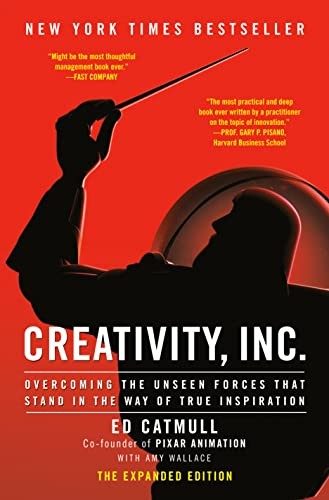Unleashing Creativity: Insights from “Creativity Inc.”
Introduction: Navigating the Creative Landscape
“Creativity Inc.” by Ed Catmull explores the depths of creativity within organizations, primarily through the lens of Pixar Animation Studios’ remarkable journey. This book serves not only as a chronicle of Pixar’s achievements but also as a strategic guide for fostering creativity and managing change in any professional setting. Catmull, as a co-founder of Pixar, shares invaluable lessons on leadership, culture, and mechanisms that empower teams to thrive in dynamic environments.
Core Frameworks and Concepts
The Braintrust Model
A pivotal aspect of Pixar’s success is its “Braintrust” model, which Catmull describes as a mechanism for providing candid feedback. The Braintrust involves regular meetings where team members engage in open, honest discussions about projects, focusing purely on the issues rather than individuals. This framework is comparable to the “Radical Candor” approach introduced by Kim Scott in “Radical Candor,” which emphasizes giving feedback that is both direct and caring.
Steps to Implementing the Braintrust:
-
Establish a Safe Environment: Create a culture that encourages openness and ensures that feedback is not taken personally but seen as a tool for growth.
-
Focus on the Project, Not the Person: Discussions should target project-related issues rather than personal attributes, fostering a constructive dialogue.
-
Diverse Perspectives: Ensure a mix of perspectives in each session to bring in varied insights and challenge assumptions.
-
Iterative Feedback Loops: Regularly revisit feedback to refine ideas, akin to the iterative cycles in Agile methodologies.
-
Empowerment to Act: Ensure that feedback results in actionable changes, empowering team members to implement improvements.
Comparison with Other Frameworks
Similar to Pixar’s Braintrust, the “Five Whys” technique, popularized in Toyota’s production system and elaborated in Eric Ries’ “The Lean Startup,” focuses on identifying the root causes of issues through iterative questioning. The difference lies in the Braintrust’s emphasis on feedback from multiple perspectives, enhancing creative solutions, while the “Five Whys” primarily targets problem-solving in operational contexts.
Key Themes
1. Building a Culture of Innovation
At the core of Pixar’s achievements is its distinctive culture that prioritizes creativity and innovation. Catmull emphasizes the importance of creating an environment where ideas can flourish without fear. Establishing a culture of openness and candor, where employees feel safe to express unconventional ideas, is crucial. This concept parallels modern agile methodologies, where iterative feedback and continuous improvement are integral.
Example: Google’s “20% time” policy allows employees to dedicate a portion of their workweek to projects they are passionate about, fostering innovation and leading to products like Gmail and Google News.
2. Embracing Change and Uncertainty
Catmull underscores the inevitability of change and the importance of embracing it as a catalyst for growth. Organizations must remain adaptable and resilient in the face of uncertainty, particularly relevant in today’s rapidly evolving digital landscape, where technological advancements and market shifts demand agility.
Comparison: In “Who Moved My Cheese?” by Spencer Johnson, the allegorical narrative highlights the necessity of adapting to change and how it can lead to growth and new opportunities. Catmull’s approach is more strategic, focusing on creating systems that anticipate and adapt to change.
3. Leadership that Empowers
Effective leadership, according to Catmull, is about empowering teams rather than dictating directions. He advocates for a leadership style that inspires trust and autonomy, allowing employees to take ownership of their work. This not only enhances motivation but also drives innovation by leveraging the collective intelligence of the team.
Example: The servant leadership model discussed in “The Servant” by James C. Hunter aligns with Catmull’s philosophy, emphasizing the leader’s role in serving their team to help them achieve their potential.
4. The Role of Failure in Success
Failure, as Catmull articulates, is an integral part of the creative process. He stresses that failure should not be feared but embraced as a stepping stone to success. At Pixar, the iterative process of creation involves numerous failures, each providing valuable insights that contribute to the eventual success of a project.
Analogy: Similar to Thomas Edison’s iterative experiments while inventing the light bulb, Pixar’s projects undergo countless revisions, learning from each misstep to achieve a successful outcome.
5. Sustaining Creativity in the Long Term
Maintaining a creative edge requires ongoing effort and vigilance. Catmull discusses the challenges of sustaining creativity over time, particularly as organizations grow and mature. He highlights the importance of continually renewing the organizational culture and processes to prevent stagnation.
Practical Insight: Instituting regular workshops, cross-functional collaboration, and investing in research and development are crucial strategies. This mirrors the continuous innovation efforts seen in companies like 3M, known for its emphasis on R&D and a culture of innovation.
Final Reflection: Transformative Insights for the Modern Professional
“Creativity Inc.” offers a treasure trove of insights for professionals seeking to foster innovation and drive change within their organizations. By embracing a culture of openness, adapting to change, empowering teams, learning from failure, and sustaining creativity, leaders can unlock the full potential of their organizations.
In an era defined by rapid technological advancement and market disruption, the lessons from Catmull’s experiences at Pixar are more relevant than ever. Applying these principles, professionals can navigate the complexities of the modern business landscape and achieve sustained success. The book’s insights resonate across various domains, from leadership and design to change management and innovation, offering a comprehensive guide for those aiming to cultivate a thriving, forward-thinking organizational culture.
Catmull’s approach aligns with broader leadership and innovation principles found in works like “The Innovator’s Dilemma” by Clayton Christensen and “Drive” by Daniel H. Pink, further cementing the idea that cultivating an environment that supports creativity and innovation is crucial for long-term success. As organizations strive to remain competitive, integrating these insights can lead to transformative change and sustained growth.

